

 The South African
The South African
by Steve A Watt
Military History Specialist, SATOUR Tour Guide,As one travels from Barberton along the R38 motorway towards Kaapmuiden, one is able to view the railway joining these two places until a point where it disappears behind a low hill. It was behind this eminence that the worst rail accident of the Anglo-Boer War occurred. On Easter Sunday, 30 March 1902, a train carrying soldiers and civilians left the rails there, incurring the deaths of 49 people. This is country where the diggings of the gold rush of 1885 had left their mark, evident in names such as Digger's Retreat, Joe's Luck, Low's Creek, Rimer's Creek, and Hyslop's Creek.
Railway accidents were not unusual during the war. A train accident at Frederickstad on 30 July 1900 left fifteen soldiers dead; at Daspoort near Pretoria nine soldiers were killed in an accident on 7 June 1901; and in another mishap in the same vicinity on 5 May 1902 another fifteen soldiers died. At Machavie near Klerksdorp a derailment of a troop train on 12 April 1902 resulted in the deaths of sixteen servicemen.
On 24 March 1902, orders were received for the 2nd Battalion Hampshire Regiment, then quartered at Barberton, to proceed to Johannesburg. Four days later, the move commenced with the departure of a party of 102 men of 'E' and the Volunteer (Militia) companies. This party reached Johannesburg on 30 March 1902 without incident.(1)
The second party of 105 soldiers was ordered to leave on Easter Sunday, 30 March 1902. It comprised three officers, 31 non-officers of 'E' Company, 29 non-officers of 'C' Company, and 39 non-officers of the Volunteer Service Company (Militia) and three details.(2) They entrained at Barberton railway station at 08.00. The train consisted of seven open trucks coupled behind the locomotive, the fourth and fifth occupied by the Volunteer Company, the sixth and seventh by 'E' Company. Then followed a 'boy' truck, a passenger coach and two more open trucks occupied by 'C' Company. The coach contained the three officers and some civilians.
The rail route from Barberton Station to Kaapmuiden descends 200 metres in altitude over a distance of 7 km. At a distance of 6,7 km the railway takes a sharp bend of 90° to the right through a distance of 250 metres, then, after a short distance, the track turns 45° to the left through 200 metres, beyond which a straight stretch crosses Hyslop's Creek.(3) On that fateful Easter Sunday, the train almost immediately proceeded down the incline at great speed. It 'must have been rushing along at least at eighty miles an hour' [148 km per hour] and 'soon the oscillation caused by the speed warned all the passengers that an accident was inevitable. It was impossible for the men to keep their seats even on the floor of the trucks. Dust and stones flew up in all directions; rifles, kits etc were thrown violently from one side of the trucks to the other, and a loud grating noise was heard, probably caused by one of the trucks which had already left the rails.'(5) At the first sharp bend, the engine hurtled into the air, turned a complete somersault, and the boiler burst as it reached the ground.(6) The couplings having been broken, 'the rest of the train rushed on at terrible speed. One truck, about 60 yards [54 metres] beyond the engine, rolled several times' before coming to a rest on its side.(7) 'Three others left the line almost simultaneously, and the fragments were piled in a heap thirty yards [27 metres] from the rails.(8)
The trucks conveying 'E' Company went as far as the middle of the culvert, one with thirty men fell to the bottom of the ravine, a drop of some ten metres,(9) the other rolled to the edge of the abyss but not before throwing its occupants out and falling onto them.(10) From this truck, 22 dead soldiers were removed. Another eight were badly injured, of whom two died later.(11) The 'store' truck, the 'boy' truck, the passenger coach, and two open trucks next to the van and the van itself crossed the culvert. The wheels of the coach and van left the rails, those on the left side running between the tracks along the middle of the foot board of the bridge and those on the right running along the outer girder to within 75 mm of the edge.(12) With great presence of mind, the guard, named Ross, applied the handbrake and 'undoubtedly saved the passenger coach from being hurled into the donga [ravine]'.(13) However, the coach was wrecked. In an attempt to ensure his safety, one passenger, a Mr William John White, had jumped off before the coach reached the bridge and he was afterwards found dead at the bottom of the ravine.(14) None of the passengers in the coach was seriously hurt except a Boer woman from the Barberton Concentration Camp, who died later.(15) The 'boy' truck was tilted on its side, whilst the buffer of the 'store' truck in front smashed into its end.(16) The doors of the 'boy' truck had closed themselves during the final smash and its occupants were released by a man who managed to open the upper door from the outside with great difficulty.(17)
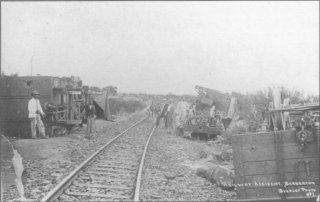
Scene of the railway accident, March 1902
(Photo: By courtesy of the Barberton Museum)
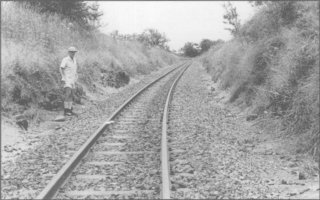
Today the cutting affords a less steep gradient for the railway.
In the 1950s, the original wooden sleepers were replaced by metal ones.
Apart from these modifications, however,
little has changed over the past 98 years.
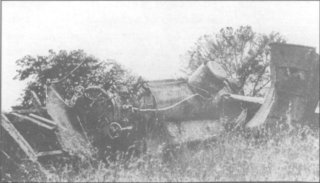
The engine was the first component to leave the rails.
After somersaulting, the locomotive came to a rest,
the boiler bursting on impact.
(Photo: The Graphic, January to June 1902)
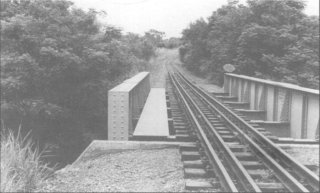
The view today of the bridge over Hyslop's Creek.
The sharp 45° bend is visible in the distance.
It was there that only eight of the original fourteen
units of the train remained on the rails.
Guide rails between the tracks serve to prevent a derailment.
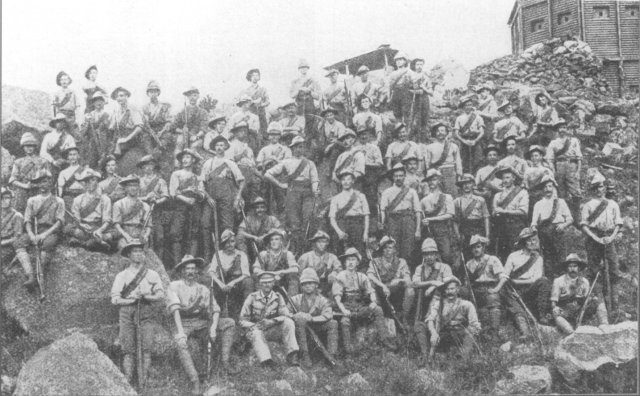
Men of the Volunteer Service Company, Hampshire Regiment, pose for a photograph near Barberton.
In the background is a blockhouse of an early design.
Sadly, some of the men pictured above were killed in the accident.
(Photo: The Graphic, January to June 1902)
| Summary of Casualties(28) | |||||
|---|---|---|---|---|---|
| Regiment | No on train | Killed | Died of injuries | Injured | Uninjured |
| Hampshire 'E' Coy | 31 | 23 | 1 | 5 | 2 |
| Hampshire Vol Coy | 39 | 7 | 3 | 25 | 4 |
| Hampshire 'C' Coy | 29 | 6 | 0 | 9 | 14 |
| East Kent | ? | 0 | 0 | 2 | 0 |
| Details | 3 | 2 | 0 | 0 | 0 |
| Civilians | 21 | 5 | 2 | ? | ? |
| TOTAL | ? | 43 | 6 | ? | ? |
| Roll of Honour Military (all buried in the Garden of Remembrance) |
|||||||
|---|---|---|---|---|---|---|---|
| Rank | Name | Initials | Regiment | Cause of death | Date | Grave | Remarks |
| Pte | Bailey | B | 3rd Bn Hampshire | K | 30-03-1902 | 4 | |
| Pte | Barge | S | 3rd Bn Hampshire | K | 30-03-1902 | 2 | |
| Pte | Beavis | W | 2nd Bn Hampshire | K | 30-03-1902 | 6 | |
| Pte | Bristowe | W | 2nd Bn Hampshire | DOI | 30-03-1902 | 3 | Vol Coy |
| Pte | Burns | C | 2nd Bn Hampshire | K | 30-03-1902 | 5 | |
| Pte | Butler | A | 2nd Bn Hampshire | K | 30-03-1902 | 7 | |
| Cpl | Childs | C | 2nd Bn Hampshire | K | 30-03-1902 | 8 | |
| Pte | Frampton | C | 2nd Bn Hampshire | DOI | 31-03-1902 | 10 | Vol Coy |
| Pte | Fransham | D | 2nd Bn Hampshire | K | 30-03-1902 | 11 | |
| Pte | Freemantle | B | 2nd Bn Hampshire | K | 30-03-1902 | 9 | Vol Coy |
| Pte | Gray | G | 3rd Bn Hampshire | K | 30-03-1902 | 13 | |
| Pte | Hansell | W | 2nd Bn Hampshire | K | 30-03-1902 | 20 | |
| Pte | Hawkesworth | W | 2nd Bn Hampshire | K | 30-03-1902 | 21 | |
| Pte | Heath | H | 2nd Bn Hampshire | K | 30-03-1902 | 22 | |
| Cpl | Hendy | C | 2nd Bn Hampshire | DOI | 31-03-1902 | 14 | Vol Coy |
| Pte | Hodgkins | C | 2nd Bn Hampshire | K | 30-03-1902 | 19 | Vol Coy |
| LCpl | Hodgson | E | 2nd Bn Hampshire | K | 30-03-1902 | 16 | |
| LCpl | Humphreys | G | 2nd Bn Hampshire | K | 30-03-1902 | 17 | |
| Pte | Kellaway | A | 2nd Bn Hampshire | K | 30-03-1902 | 23 | Vol Coy |
| Pte | Kenrick | H | 2nd Bn Hampshire | K | 30-03-1902 | 24 | |
| LCpl | Light | F | 2nd Bn Hampshire | K | 30-03-1902 | 25 | |
| LCpl | Moody | W | 2nd Bn Hampshire | K | 30-03-1902 | 27 | Vol Coy |
| Pte | Peale | H | 2nd Bn Hampshire | K | 30-03-1902 | 80 | |
| Pte | Pitt | S | 3rd Bn Hampshire | K | 30-03-1902 | 30 | |
| Pte | Purcell | D | 2nd Bn Hampshire | K | 30-03-1902 | 31 | |
| LCpl | Richens | C | 2nd Bn Hampshire | K | 30-03-1902 | 33 | |
| Pte | Smith | T | 2nd Bn Hampshire | K | 30-03-1902 | 85 | |
| Pte | Spanner | W | 2nd Bn Hampshire | K | 30-03-1902 | 34 | |
| Pte | Steel | G | 2nd Bn Hampshire | K | 30-03-1902 | 37 | |
| Pte | Stone | P | 2nd Bn Hampshire | K | 30-03-1902 | 84 | |
| Pte | Swatton | W | 2nd Bn Hampshire | K | 30-03-1902 | 35 | |
| Pte | Teelin | B | 5th Bn Leinster | K | 30-03-1902 | 86 | |
| Pte | Urty | G | 2nd Bn Hampshire | K | 30-03-1902 | 38 | |
| Pte | Watson | H | 2nd Bn Hampshire | K | 30-03-1902 | 40 | |
| Pte | White | CH | 2nd Bn Hampshire | K | 30-03-1902 | 41 | |
| Pte | White | TR | 2nd Bn Hampshire | K | 30-03-1902 | 44 | Vol Coy |
| Pte | White | W | 2nd Bn Hampshire | K | 30-03-1902 | 42 | |
| Pte | Wilkins | J | 2nd Bn Hampshire | K | 30-03-1902 | 44 | |
| Pte | Winsor | C | 3rd Bn Hampshire | K | 30-03-1902 | 39 | |
| Pte | Woodford | P | 2nd Bn Hampshire | K | 30-03-1902 | 45 | Vol Coy |
| Pte | Wright | B | 2nd Bn Hampshire | DOI | 31-03-1902 | 46 | |
| Pte | Youde | T | 2nd Bn Hampshire | K | 30-03-1902 | 48 | Vol Coy |
| Civilians | ||||
|---|---|---|---|---|
| Name | Initials | Organisation | Cause of death | Date |
| Constance | JL | Imp Mil Railways | DOI | 30-03-1902 |
| Rankin | J | Imp Mil Railways | K | 30-03-1902 |
| White | WJ | K | 30-03-1902 | |
| [Boer woman] | DOI | ? | ||
| 3 Blacks | K | 30-03-1902 | ||
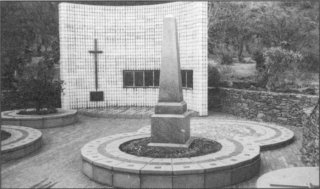
The Hampshire Regiment Memorial in the Barberton Garden of
Remembrance bears the names of the 42 men who died as a result
of the train accident, as well as eight who died of other causes.
By making comparisons between a map of the area, photographs depicting the scene of the accident, and the actual terrain as it appears today, the author came to the conclusion that the trackbed of the railway has undergone change since that fateful day in March 1902. The trackbed along the two bends has been widened and deepened but the curvature remains the same. The angle of depression of the railway has been decreased in order to reduce the gradient of the line. In addition the piers of the bridge over Hyslop's Creek now stand taller, not only to ease the steepness of the slope, but also to accommodate the floodwaters beneath it. The railway sleepers date back to 1950, and both the track and the sleepers are rusty, lending itself to the idea that the railway is not used much today.
All the British graves were exhumed from the Barberton Cemetery and the soldiers' remains were re-interred in the Barberton Garden of Remembrance located on the north side of the town. Apart from the main memorial listing the names of all those buried in the Garden, there is a monument to the 2nd Battalion Hampshire Regiment 'Erected by the Officers, NC Officers and Men of the Regular, Militia and Volunteer Battalions of the Hampshire Regiment in memory of those who were killed in the railway accident (Easter Day) 1902 and also of those who died of disease during the period the 2nd Battalion were quartered in Barberton.'
References
1. Hampshire Regimental Journal.
2. Hampshire Regimental Journal.
3 Observations made by the author. See also 1:50 000
topographical maps 2531 CA SHEBA, 2531 CC Barberton.
4. The Natal Witness, 24 April 1902.
5. Hampshire Regimental Journal.
6. The Natal Witness, 24 April 1902.
7. The Natal Witness, 24 April 1902.
8. The Natal Witness, 24 April 1902.
9. Hampshire Regimental Journal.
10. The Natal Witness, 24 April 1902.
11. The Natal Witness, 24 April 1902.
12. The Natal Witness, 24 April 1902.
13. The Natal Witness, 24 April 1902.
14. Hampshire Regimental Journal; The Natal Witness, 24 April 1902.
15. The Natal Witness, 5 April 1902.
16. Hampshire Regimental Journal.
17. Hampshire Regimental Journal.
18. Hampshire Regimental Journal.
19. Atkinson, CT, History of the Royal Hampshire Regiment; Hampshire
Regimental Journal.
20. The Natal Witness, 24 April 1902.
21. The Natal Witness, 24 April 1902.
22. The Natal Witness, 24 April 1902. According to the Hampshire
Regimental Journal, 'a relief train arrived from Kaapmuiden about
5pm and before dark all the dead and injured had been conveyed
back to Barberton and the line was open for traffic.' The author is
of the opinion that this statement is incorrect.
23. The Natal Witness, 5 April 1902.
24. Hampshire Regimental Journal.
25. The Natal Witness, 24 April 1902.
26. The Natal Witness, 24 April 1902.
27. Hampshire RegimentalJournal; The Natal Witness, 24 April 1902.
28. Hampshire Regimental Journal; research by the author.
Bibliography
Atkinson, CT, History of the Royal Hampshire Regiment (c 1935).
The Graphic, January 1902.
The Graphic January-June 1902.
The Hampshire Regiment Casualty List. The Royal Hampshire Regiment Museum.
The Hampshire Regimental Journal, April 1912.
The Natal Witness, 24 April 1902.
The Natal Witness, 5 April 1902.
South African War Casualty Roll. (Polstead, London, 1982).
Acknowledgements
The author would like to thank the following:
The curatrix of the Barberton Museum for permitting the
author access to the photographic material.
Mr Maurice Gough-Palmer for his enthusiasm and
unselfish assistance in showing the author the locality of
the Anglo-Boer War grave sites and the documentation
thereof, without which the story would have remained
untold.
The Royal Hampshire Regimental Museum, Winchester,
Hampshire, England.
Return to Journal Index OR Society's Home page
South African Military History Society / scribe@samilitaryhistory.org